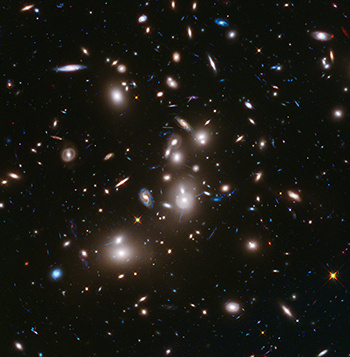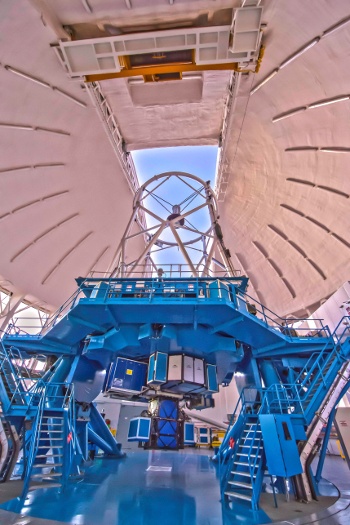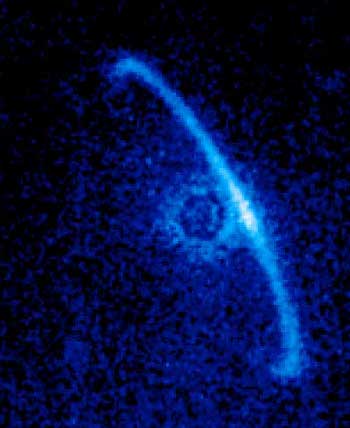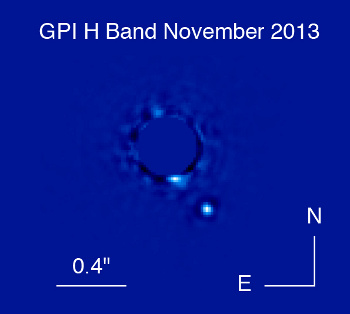Gemini Planet Imager
January 17, 2014
I was a child of the
Space Race. I was nine when
Sputnik 1 was launched on October 4, 1957. There wasn't a man in
space until
Yuri Gagarin's single
orbit flight in
Vostok 1 on April 12, 1961. However, every
satellite launch was
front page news in that three and a half year interval. Space was exciting, even without the human element.
I remember being one of many
elementary school students watching
televised coverage of the first few
US manned space launches on a very small screen in the school
auditorium. When I was in
college, there were men walking on the
Moon, but public interest quickly waned. Each Moon mission topped the others with items such as a
Moon buggy, but it had become all too routine.
After a
space shuttle servicing mission solved its
initial focusing problem, the
Hubble Space Telescope returned spectacular images from 1994 onwards. Some of these have an
aesthetic quality; but many, such as the
deep field image shown below, are important
scientifically.

An example of a Hubble Space Telescope deep field image, a photograph of 3,000 distant galaxies focused through gravitational lensing by the foreground galaxy, Abell 2744. These galaxies appear as they were 12 billion years ago.
(Image: NASA, ESA, J. Lotz, M. Mountain, A. Koekemoer, and the HFF Team, via the Space Telescope Science Institute.)[1)]
However, just as for manned spaceflight, such images no longer generate much public interest. The
human mind is wired to seek
novelty, and when the novelty in one area wanes, we look somewhere else. The same was true for me, until the recent release of the first images from the
Gemini Planet Imager of the
Gemini South Telescope, located in
Cerro Pachon, Chile (
30.24073°S 70.73659°W). This telescope is part of the
Gemini Observatory.[2-9]
The Gemini Planet Imager was designed to obtain high contrast images of
extrasolar planets around nearby
stars. It operates at
near-infrared wavelengths for which the extrasolar planets will be bright, but the
thermal emission from the
Earth's atmosphere isn't too strong.
The Gemini Planet Imager was a huge, long-term collaboration of the
American Museum of Natural History, the
Dunlap Institute, the
Gemini Observatory, the
Herzberg Institute of Astrophysics, the
Jet Propulsion Laboratory,
Lawrence Livermore National Laboratory, the
Lowell Observatory, the
SETI Institute,
The Space Telescope Institute, the
University of Montreal, the
University of California, Berkeley, the
University of California, Los Angeles, the
University of California, Santa Cruz, and the
University of Georgia. The
principal investigator of the project is
Stanford University physicist,
Bruce Macintosh, working at Lawrence Livermore National Laboratory for this project.[3]

Gemini Planet Imager mounted on the Gemini South Telescope, one of the world's largest telescopes at 26-feet/8-meters.[5]
The Imager, which is the size of a small automobile, is the collection of boxes at the base of the telescope.
Aside from the essential adaptive optics system, the Imager includes a coronagraph, a calibration interferometer, and a spectrograph.
(Gemini image.)
Nearly a thousand extrasolar planets have been detected, but most of these detections have been indirect, based on the
slight wobble of their parent star as they
orbit. Direct imaging is preferable, since it can be used to estimate a planet's size,
temperature,
gravity, and, perhaps, the composition of its
atmosphere. Direct imaging is a challenge, since the light emitted by even a
Jupiter-sized planet is a billion times fainter than its parent star, and planets orbit close to their stars.[3,5]
The Gemini Planet Imager is designed to detect extrasolar young
gas giants, one million to one billion years in age. Such young planets retain
heat from their
formation, so they can be detected by their
infrared emission in the
wavelength range of 0.9 and 2.4
micrometers. The Gemini Planet Imager can also detect the components of their atmospheres. Since Earth-based observation is difficult, these is the only type of planet that it can see.[2,4-5]
Earth-based direct observation of such extrasolar planets is only possible because of
adaptive optics. The Gemini Planet Imager is based on a
MEMS deformable mirror, which removes atmospheric
turbulence. The two
centimeter-square deformable mirror is composed of 4,000
actuators, etched into
silicon. It can adjust its shape with accuracy better than a
nanometer a thousand times per second.[3] It corrects atmospheric turbulence sensed by another system component. Another device, called a
coronagraph, blocks light from the parent star.

Gemini Planet Imager view of disk of dust orbiting the young star HR 4796A.
The sharp edge of the ring, debris remaining from planet formation, is thought to be defined by an unseen planet.
The image contrast was increased through the use of polarization detection.
This image and others were released at the 223rd meeting of the American Astronomical Society.
(Via Lawrence Livermore National Laboratory.)
Says principal investigator, Bruce Macintosh,
"Even these early first-light images are almost a factor of 10 better than the previous generation of instruments. In one minute, we were seeing planets that used to take us an hour to detect."[2-4]
The plan for 2014 is a survey to scan 600 young stars to see whether these host similar giant planets. Long term plans are for a similar, satellite-based instrument capable of imaging smaller extrasolar planets.[2,4]

Gemini Planet Imager view of planet Beta Pictoris b, the small dot at the lower right side of this image.
Beta Pictoris b, a planet several times larger than Jupiter, is only ten million years old.
(Via Lawrence Livermore National Laboratory.)
![]()
References:
- Hubble's First Frontier Field Finds Thousands of Unseen, Faraway Galaxies, Space Telescope Institute Press Release No. STScI-2014-01, January 7, 2014.
- Gemini Planet Imager First Light!, Gemini Observatory Press Release, January 7, 2014.
- Anne M Stark, "Out of this world first light images emerge from Gemini Planet Imager," Lawrence Livermore National Laboratory Press Release No. NR-14-01-01, January 7, 2014.
- World's Most Powerful Planet Finder Turns its Eye to the Sky - Gemini Planet Imager Obtains First Light Images, SETI Institute Press Release, January 7, 2014.
- Whitney Clavin, "Powerful Planet Finder Turns Its Eye to the Sky," NASA JPL Press Release, January 7, 2014.
- Anne M Stark, "The search for planets and stars out of this world," LLNL news story, June 6, 2011.
- Gemini Planet Imager Web Site.
- Gemini Observatory Web Site.
- Gemini Planet Imager blog.
Permanent Link to this article
Linked Keywords: Space Race; Sputnik 1; outer space; Yuri Gagarin; geocentric orbit; Vostok 1; satellite; newspaper; front page news; elementary school; student; television; televised; United States; US; auditorium; college; Moon; Lunar Roving Vehicle; Moon buggy; STS-61; space shuttle servicing mission; flawed mirror; Hubble Space Telescope; aesthetic; Hubble Deep Field; deep field image; science; scientific; galaxy; gravitational lens; gravitational lensing; Abell 2744; NASA; European Space Agency; ESA; HFF Team; Space Telescope Science Institute; human mind; novelty; Gemini Planet Imager; Gemini South Telescope; Cerro Pachon, Chile; 30.24073°S 70.73659°W; Gemini Observatory; exoplanet; extrasolar planet; star; near-infrared wavelength; thermal radiation; thermal emission; Atmosphere of Earth; American Museum of Natural History; Dunlap Institute; Herzberg Institute of Astrophysics; Jet Propulsion Laboratory; Lawrence Livermore National Laboratory; Lowell Observatory; SETI Institute; The Space Telescope Institute; University of Montreal; University of California, Berkeley; University of California, Los Angeles; University of California, Santa Cruz; University of Georgia; principal investigator; Stanford University; physicist; Bruce Macintosh; foot; meter; >automobile; adaptive optics; coronagraph; calibration; spectrograph; radial velocity; wobble; orbit; temperature; gravity; atmosphere; Jupiter; gas giant; heat; nebular hypothesis; formation; infrared; wavelength; micrometer; microelectromechanical system; MEMS; deformable mirror; turbulence; centimeter; actuator; silicon; nanometer; HR 4796A; polarization detection; 223rd meeting; American Astronomical Society; Beta Pictoris b.